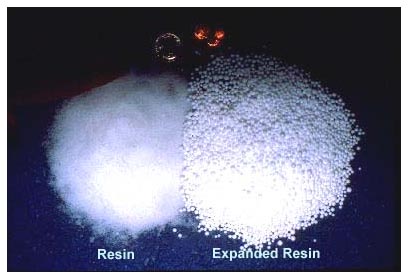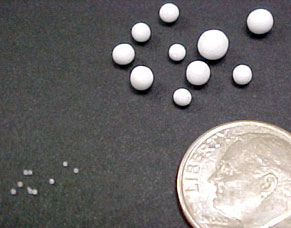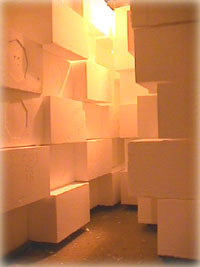

The covers foam core is the "back bone" of every spa cover. Not only is it the main insulating factor, it also provides the strength needed for years of use. One of the important features of our foam is that it's a virgin foam, rather than recycled. While both may have the same insulating value, recycled foam doesn't have nearly the strength as the virgin foam we use.
The two important aspects of the foam are the thickness and the density of the foam. Each effects the overall strength and insulating ability of the spa cover. We offer a variety of thickness and densities to suit every need.
| Deluxe Basic |
Deluxe Standard |
Deluxe Plus |
Extreme Standard |
Extreme Plus |
|
| Foam Density | 1 pound | 1� pound | 2 pound | 1 pound | 1� pound |
| Foam Thickness | 4" x 2" | 4" x 2" | 4" x 2" | 6" x 4" | 6" x 4" |
| R-value | R-13 | R-14 | R-15 | R-21 | R-22 |
| Strength Rating | 1 | 1.5 | 2 | 1.66 | 2.49 |
| Overall weight (7') | 32 | 36 | 40 | 38 | 46 |
The most popular covers are the Deluxe Standard and the Extreme Standard. The foam core of the Deluxe Standard spa covers are a 1.5 pound density, metal reinforced, EPS (expanded polystyrene) foam , tapered from 4" to 2". The foam core of the Extreme Standard spa covers are a 1 pound density, metal reinforced, EPS (expanded polystyrene) foam , tapered from 6" to 4". The taper is necessary to allow accumulated water to easily run off. Many older, and some cheap covers are made of a flat foam which will allow water to puddle,causing the cover to sag, allowing more water to puddle, eventually breaking the cover.
Foam density refers to the weight of a cubic foot of foam. A 1.5 lb. density is generally the ideal for a 4" thick cover. It has excellent strength and insulating ability, yet is light enough to maneuver on and off your spa. Lesser densities are NOT advised for a cover of this thickness due to their lack of strength. With our 6" thick cover, a 1 pound density is more than enough. It provide almost 50% more insulation value over our 4" cover, is stronger, yet is the same weight. Higher foam densities have additional strength, but only slightly more insulating ability. One of the many options we offer is upgrading to a higher density foam if additional strength is needed.
Please note, these measurements are the true measurement of the foam itself. It is not a nominal measurement, nor does it include the thickness of the vinyl or vapor wrap (you'd be surprised how many others don't use a "true" measurement, and add in thickness of the other materials used).
Expanded Polystyrene, or EPS for short, is a lightweight, closed cell, rigid, plastic foam insulation material produced from solid beads of polystyrene. EPS's properties of low thermal conductivity, high compressive strength and excellent shock absorption properties make it an ideal material for many uses. Expansion is achieved by virtue of small amounts of pentane gas dissolved into the polystyrene base material during production. The gas expands under the action of heat, applied as steam, to form perfectly closed cells of EPS. These cells occupy approximately 40 times the volume of the original polystyrene bead. The EPS beads are then molded into appropriate forms suited to their application.


There are 3 manufacturing stages to attain EPS foam blocks:
Pre-expansion:
Polystyrene granules (resin) are expanded by free exposure to steam to form larger beads, each consisting of a series of non-interconnecting cells.The raw material resin used to manufacture EPS is received in the form of small beads ranging from 0.5 to 1.3mm in diameter. These small beads are formulated and manufactured by the suppliers to contain a small percentage (4% - 5%) of the naturally occurring gas pentane. This gas is impregnated throughout the body of each small bead. The pre-expansion phase of manufacturing is simply the swelling of the small bead to almost 50 times its original size through the heating and rapid release of the gas from the bead during its glass transition phase.
Conditioning:
After expansion, the beads still contain small quantities of both condensed steam and pentane gas. As they cool, air gradually diffuses into the pores, replacing, in part, the other components. Most manufacturers run the finished beads through a dryer to remove any surface moisture. Then they're stored in large open storage bags for an aging process. Besides the steam and gas in the beads there are also areas of internal vacuum in the millions of cells created. This vacuum must be equalized to atmospheric pressure otherwise this delicate balance may result in the collapse, or implosion, of the bead. This process of aging the expanded beads allows the beads to fill back up with air and equalize. This aging can take from 12 hours to 48 hours, depending on the desired expanded density of the bead.After this process they're ready to be formed onto solid blocks of foam.
Molding:
The molding process involves taking the loose expanded beads and forming them into a solid block mass. A mold is filled with a specific amount of beads. A vacuum system evacuates any residual air from the mold. The vacuum is relieved by live steam which flows over the entire mass of beads in the cavity. This vacuum process softens the polymer structure of the bead surface and is immediately followed pressure compressing the beads and more live steam. The latent heat from the steam and subsequent pressure increase cause the beads to further expand. Since this is a confined environment, the only way the beads can expand is to fill up any voids between them causing the soft surfaces to fuse together into a polyhedral type solid structure. Pressure is released after a predetermined time and the loose beads are now fused into a solid block of foam. The density of the foam has been predetermined by the amount of pressure exerted on the beads while in the mold.
Following a short cooling period, the molded block is removed from the machine, and
after further curing and conditioning, may be cut or shaped as required using hot wire
elements or other appropriate techniques.
